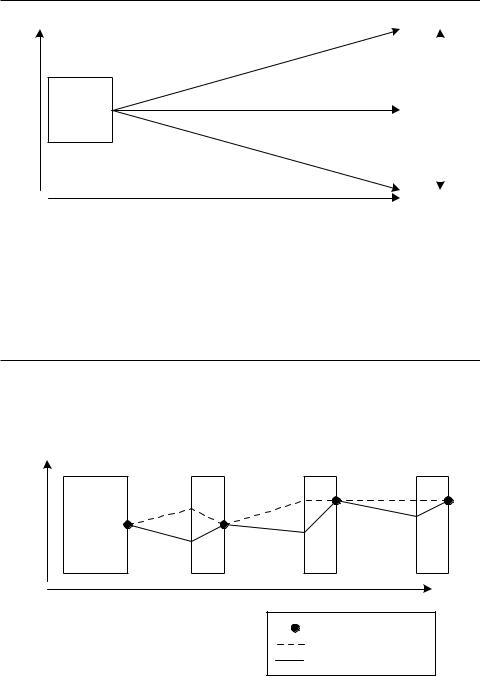
project_management_made_easy
.pdf
Risk: Manage Uncertainty
Inform everyone involved in the project and in any other deadlines you have. Explain that something big is up. Find out who has leeway and who doesn’t. You may find that some people are unexpectedly generous or that someone else is running behind on his or her part of the work, so that a delay on your side doesn’t matter.
Decide what option costs the least to your business.
Implement that option, whether it’s to delay the project, cancel the project, put the project on hold, or spend a bunch of sleepless nights.
Inform everyone that you’re working in what I call “crisis mode.”
Focus on getting each job done, one at a time.
But What About a Disaster?
A risk event is not a disaster. A risk event is something that has at least a fair chance of happening during a project that will force a change in the project. A disaster is a big, rare event that is unlikely. Disaster preparedness, often called business continuity planning, is a whole different topic. And, when a disaster happens, it requires a whole different approach than the reaction to a risk event being triggered.
In case of a business disaster, decide what is best for the business. It might be best to cancel the project or put it on hold. Or, it might be best to continue. Face the disaster, continue your business, and make choices that make things safe through the storm and increase your chances of clearing away the damage and rebuilding afterwards.
Of course, risk events take effort, the work to handle the risks costs money, sometimes there are other expenses, and sometimes they cause us to miss deadlines and delay project delivery. We should take our risk plan into account when creating the project schedule and budget. It is unrealistic to expect no risk events to occur, just as it is unrealistic to think that they will all happen. Technically, this extra time and money to handle risk events is called a contingency in our schedule and budget. Practically, as long as we are within those contingencies, our project is on time and within budget. If the risk events are so large or so numerous that we can’t get the whole job done on time and within budget, then we will know it as soon as we can, because we are tracking all of this as we go. And, when we know it, we can escalate from project
157

If you don’t sink and you keep
moving in the right direction, eventually you’ll get to your destination.
Project Management for Small Business Made Easy
risk management to project change management. We revise our plan, either adding time and money to make it all the way to the end of the project or dropping something from the scope, as we discussed in Chapter 13, Keeping Everything on Track.
Conclusion: Sailing Through Stormy Waters
Just like sailing trips, some projects are easier than others. If you have a fair wind and clear weather, wonderful! But that isn’t a reason not to pack life preservers and storm sails, not to practice using them, or not to keep a storm watch. Risk readiness pays off as soon as a storm hits. Preparedness, fast response, and a strong hand at the helm to steady the ship through the storm while moving in the right direction as best we can will allow us to reach our destination. That’s the beauty of PDCA: as long as we’re moving more or less in the right direction, even slowly, we can keep correcting course and speed until all the work is done and we deliver the scope of the project on time and on budget or with planned, approved changes that we may need to make.
We’ve now learned all that there is to know to manage our project through the doing stage. However, we also have to manage our customers in the doing stage—and that is the subject of Chapter 18, Managing Expectations.
158

Chapter 18
Managing
Expectations
IT IS PERFECTLY POSSIBLE TO DEFINE A PROJECT CORRECTLY, DO THE RIGHT
job, and deliver to specification on time and within budget—and for the project to be a total disaster. Why? Because it is not enough to meet the customers’ specifications; we have to meet their expectations as well.
Expectations are often unspoken. Like unwritten assumptions, unspoken expectations can be the death of a project. If we want to satisfy our customers by delivering project results, we need to bring expectations under management. We can do this if we take the following steps:
Discuss expectations openly.
Document expectations into the specification.
Define the expectations gap.
Manage the expectations gap with gate reviews that include the customers.
Ensure ongoing communication with all customers.
If we take these five steps, we will manage expectations and prepare for achieving customer delight, the topic of Chapter 20.
159

You can meet expectations only if you know
what they are.
Never assume you under-
stand the customer. Ask—and ask again.
Be friendly, and be clear.
Project Management for Small Business Made Easy
Discuss Expectations Openly
I am perpetually amazed by how much well-meaning professionals who think clearly misunderstand one another. Some of the problems come from not taking the time to explore and listen well enough. Some of the problems come because we have different professional backgrounds and areas of expertise, so that our assumptions are different. As a result, what one person calls “expensive” another calls “cheap.” For example, when I was moving to San Antonio, a real estate agent was afraid to show me the type of rental property I wanted. She thought I would turn white when I heard the price. But I’d lived in Manhattan and paid about the same rent for less than half the space. She not only didn’t try to find out what my assumptions were, but actively avoided getting them. I had to insist that, in the San Antonio market, price was not an issue. Only then did I get what I wanted.
We can do better than that. We need to open honest dialog about expectations and assumptions. When we do, we need to explain that there will be misunderstandings and that we want to find them early and prevent them from creeping in. We will do this in three steps:
In the preparation stage, we define terms clearly and define precisely what the customer wants, turning expectations into specifications.
In the doing stage, we maintain communications, so that expectations remain clear and are coordinated with the specification and so that any necessary changes get into the project plan.
In the follow-through stage, we bring the product, service, or project result and the customer together and we take time to ensure that it meets expectations and specification to the customer’s satisfaction and that the customer will benefit from the project results after the project is over.
We can do this only by enticing the customer to meet with us, work with us, and talk to us.
Documenting Expectations
All our business communication becomes useful only when it is written down and when people agree to use the written documents and treat them as author-
160

Managing Expectations
itative. We all like to believe that our memories are clear and that there was mutual understanding at meetings. The truth—revealed by psychological experiments and studies—is that even people regarded as having excellent memories often do not, in fact, remember things correctly. To avoid confusion, disappointment, and rework, put everything in writing.
The specification is the written statement of expectations. We should adhere to it and make sure that the customers understand that they will adhere to it as well. This is a strict rule, but we can present it in a very friendly way and be friendly and cooperative throughout the process. For example, adhering to the written specification doesn’t mean it is set in stone. If, during the doing stage, a customer wants a change and we can do it and if we agree on a time and a price, then we agree, we change the written plan, and we deliver.
Our ultimate goal is to provide the greatest value we can for the customer. We are strict not because we’re selfish or we want to do less. We are strict because we understand that, to deliver any value at all, the project must succeed. And project management is risky. In doing communications management, we bring expectations under control, so that we can meet them and deliver customer delight.
In business, written agreements
should replace memory.
The specification is a living document. If done well, it will change little, but we can agree to
change it.
Defining the Expectations Gap
Even when we have followed all the steps in Chapters 6 and 10 and what is written here, we have only specified the customers’ expectations at the end of planning. Now, we have to keep expectations under management in the doing stage.
People tend to “remember” that they’re going to get everything they want, even if they didn’t ask for it. We also tend to dream of more things and somehow expect those to happen, as if by magic. While the customer’s expectations are expanding, inflated by hopes and dreams, the specification isn’t changing and actual results may be drifting downwards. While the customer is dreaming, the team is working, running into problems, and maybe dropping the ball here and there. Work quality results are likely to go down if we don’t do anything to manage them. If we are not careful, this leads to a large gap, as illustrated in Figure 18-1, where the customer expects more than the specification and the team delivers less.
If the project ends with expectations higher than the results, we have a disappointed customer—even if we deliver to specification. To prevent this, we
Dreams expand while
results shrink.
161

Project Management for Small Business Made Easy
Expectations
Original
Scope
Statement
Increase
Expectations
Customer
Specification Stays the Same
Work |
Results |
Degrade |
|
||
|
|
Endof Project |
|
TheExpectations Gap |
|
||
|
|
|
|
|
|
Time
Figure 18-1. A project without gates allows an expectations gap
need more than just communication. We need clear, specific communication in a structured process. We create that by including the customer in each review gate.
Managing the Expectations Gap
The solution that manages expectations and results to prevent the expectation gap is gate reviews that bring the project up to specification while bringing the customer back down to earth, as shown in Figure 18-2.
Expectations
|
|
End of |
Gate |
Gate |
Project |
Original
Scope
Statement
Time
Specification Level
Customer Expectation
Work Results
Figure 18-2. Managing expectations with gate reviews
162

Managing Expectations
In Figure 18-2, we show the two benefits of gate reviews. We use the gate to identify gaps between the specification and the work results. We then have the team improve the work results to meet the specification. At the same time, we bring the client to the gate review to get project status and see the product under development.
In the first gate in Figure 18-2, the client had some expectations that we understood as change requests, but rejected, bringing their expectations down to the specification. At the second gate, the client understood what kind of change request mattered. The client made a request—an increased expecta- tion—and we approved the change request, increasing the specification to match the client’s expectation. At the same time, we had the team do the work so that the results matched the new, higher specification. We then told the client that we couldn’t afford any late changes to the project, so expectations stayed level to the end of the project. The work results dropped a little from the specification, but we fixed that in closing the project. As a result, we delivered not only to specification, but also to expectations.
Note that this process of ongoing, clear communication with the customer at gate reviews did more than eliminate the expectations gap. It also actually improved the specification and guided the team to deliver everything in the original specification and more. When the team members get to work effectively with the customers, they have a chance to do good work for people that they have actually met, which inspires them to do good work and deliver delight.
When we create gate reviews that include the customers, we must define the review to be appropriate. You don’t want to overload customers with technical jargon until their eyes glaze over and they say, “OK, OK,” just to escape. At the same time, you don’t want to do a superficial job. Sort through the review milestones and decide which of the stakeholders should see what. You can refer to the communications plan, where you associated stakeholders with using—and therefore checking—different work packages. In addition, you should prepare appropriate presentations, which may include visuals or even physical prototypes for evaluation or testing.
Customers usually focus on one set of issues and the project team on another. Here is what most customers care about:
Benefits. What will this do for me?
Gate reviews are a chance
to stay in tune with your customer.
163

Project Management for Small Business Made Easy
Features. What has this got?
Usability. How do I make this work? What do I do to get my work done or my satisfaction from this product or service?
Someone on the customer side will probably also be concerned about technical issues over the long haul such as installation, maintenance, compatibility, upgrading, disaster recovery, and replacement. Usually, we should meet with one customer representative separately on those issues.
At each gate review, the team is more likely to be concerned with these issues:
Components. What’s in here?
Requirements. Does each thing work? Does it do what it’s supposed to do?
Of course, there is a connection here. If the components meet the technical requirements and the technical requirements were designed to meet the functional specifications, then the product will be usable, with each feature working. If the product is easy to use and the features work, it will offer the benefits we planned. If it offers those benefits and we keep other expectations under management, then we will satisfy the customer.
I can’t emphasize enough how important it is to meet expectations. You can do the best job in the world, but if the customers don’t get what they expect, they will be disappointed. And each disappointed customer is one step toward a bad reputation—which is the last thing that a small business wants.
Ensure Communication with All
Customers
So far, we’ve been talking as if the customer is just one person or as if all customers will want the same thing. Of course, that’s not really true. So, now we need to talk about how to manage each customer’s expectations and how to satisfy or delight each customer. There are two situations—one where we deliver a product to a group of customers and the other where we sell many products to many customers.
164

Managing Expectations
Managing Customer Expectations for a Group
In this case, the project might be a new computer system for a company or it might be a catered event, such as a wedding. If the target is a business customer, we need to address the expectations of three groups:
Executives who want to make sure the results are valuable to the company.
Managers who want to make sure that the department’s work gets done, that the project doesn’t interfere with routine work, and that, in the end, it will be easier, not harder, to work with the new system they will have when the project is done.
Workers who want to know that their jobs will be easier with the new system.
Of course, in addition to these reasonable expectations that these people will have due to the goals of their jobs, people may also have personal preferences. We meet those when we can and manage them when we can’t.
In addition to the customers, there may be other stakeholders, that is, other people who are affected by project results. We should maintain communications with all stakeholders.
How Much Money Are We Making?
One time, a computer consulting group designed and installed a customer relations management (CRM) system for a business client. CRM is a single system that supports marketing, sales, and customer service. The consulting group went to everyone in each of those departments, found out exactly what the old system did, found out exactly what they wanted, did a great job, and delivered everything.
The result was a disaster—because the consultants had missed a stakeholder. The old system generated one report that didn’t go to anyone in marketing, sales, or customer service. That report was the daily cash report that went to the chief financial officer, showing him whether the company had made $1.5 million or only $500,000 that day. When they switched over to the new system, that report wasn’t on his desk that day and he didn’t know if the company was in the black so he could pay bills or in the red so that he had to borrow money that day.
The Lesson: Find every stakeholder, find what each one needs, and deliver it.
165

Project Management for Small Business Made Easy
First, we specify their expectations into requirements. Then, in the doing stage, we keep them apprised of the progress of their particular requirements and include them in testing the product for the requirement they gave us. We make the product work for each stakeholder and get each stakeholder’s approval. We can include this process in the gate review or, if it is a small item, we can work with the stakeholders whenever the components that concern them are done and ready for testing.
If we are doing a project for a group of consumers, then we will need to define the customer groups. For example, for a wedding we have the bride and groom, the bride’s family, the groom’s family, adult guests, child guests, and the celebrant (priest, pastor, rabbi, or judge). What will we do to delight each of them? Once we’ve defined who’s who, we do the same process of expectation management as we would on any project.
Managing Customer Expectations for Individual Customers
If we are developing a product or service for sale, whether for businesses or consumers, then we can’t meet all our customers during the project. The best we can do is to identify the customer groups related to this type of project and include sample customers or customer representatives—such as a marketing department—in the project. We should treat those groups like customers all the
Make a Customer Map
Take a look at your industry and the kind of projects you usually do. Write down answers to these questions:
Who are your customers? Business or consumer? What kinds of companies and people?
Do you have just one customer per project or more than one?
For each customer and stakeholder, what are their typical concerns?
Once you write up your answers, you can create good marketing copy to sell your products and services by defining the benefits you offer. You can also create forms, templates, and checklists to make selling your services and doing your project work hassle-free.
The Lesson: Organize what you know about your customers to streamline projects and increase profit.
166
